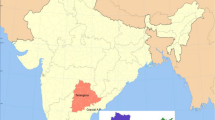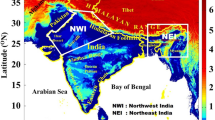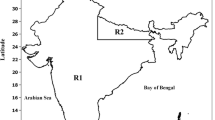Abstract
Lightning flashes (LF) and their association with meteorological variables that can influence the occurrence of lightning have been assessed in detail over the Indian domain, i.e., the Convective Available Potential Energy (CAPE), Relative Humidity (RH), Total Column Water Vapour (TCWV), Surface Temperature (ST) and Outgoing Longwave Radiation (OLR). A high-resolution dataset of LF has been retrieved from the Lightning Imaging Sensor (LIS) on board the Tropical Rainfall Measuring Mission (TRMM) satellite. The CAPE, TCWV, RH and ST from 1998 to 2013 are retrieved using ERA-Interim monthly/annual climatology while OLR was retrieved from NCEP datasets. The seasonal analysis shows that most LF occur during the pre-monsoon period (March, April, and May) (0.40–0.45 flash/km2/day) over northeast region. During the monsoon season (June, July, and August), the LF dominates over northern India (0.35–0.40 flash/km2/day). The seasonal variation of CAPE shows the maximum (1250–2250 J/kg) during pre-monsoon over the coastal area of NE and SE regions. TCWV and RH show the maximum in monsoon season over northeastern part, which is 50–70 kg/m2 and 60–80%, respectively. The dependence of LF on meteorological parameters varies from region to region, as is evident from statistical analysis. Maximum LF occurred over the NE (0.049 flash/km2/day) region, followed by the EC (0.041 flash/km2/day) and the lowest in the WC (0.027 flash/km2/day) region of India. The LF showed a significant correlation with CAPE over NE and EC of India because of higher humidity content values over the coastal regions, which form graupel through convection. Over the WH, LF and CAPE showed a good correlation (r = 0.94) because of orographic convection processes. Further, TCWV showed significant correlation with LF over WH (0.89) and minimum over WC (0.23) region. Principal component analysis (PCA) shows that lightning is well correlated with CAPE, RH, TCWV and ST over most regions in India. However, lightning is not significantly correlated with OLR. Understanding the meteorology of lightning across the Indian region can inform forecasting of possible lightning events and is relevant for assessing lightning for human, wild risk and climate projections.
Research highlights
-
The regional-scale meteorological variables associated with lightning are identified.
-
Due to the regional orography, lightning flashes show high correlation in proximity to meteorological variables.
-
The spatio-temporal distribution shows that most of the lightning flashes occur during March, April and May (MAM) months over North East region.
-
The impact of meteorological variables is visible as the study's threshold values change over time.












Similar content being viewed by others
References
Albrecht R I, Goodman S J, Petersen W A, Buechler D E and Bruning E C 2011 The 13 years of TRMM lightning imaging sensor: From individual flash characteristics to decadal tendencies; XIV International Conference on Atmospheric Electricity, August 8–12, 2011, Rio de Janeiro, Brazil.
Baker M B 1997 Cloud microphysics and climate; Science 276(5315) 1072–1078.
Boccippio D J, Goodman S J and Heckman S 2000 Regional differences in tropical lightning distributions; J. Appl. Meteorol. Clim. 39(12) 2231–2248.
Bond D W, Steiger S, Zhang R, Tie X and Orville R E 2002 The importance of NOx production by lightning in the tropics; Atmos. Environ. 36(9) 1509–1519.
Chakraborty R, Chakraborty A, Basha G and Ratnam M V 2021 Lightning occurrences and intensity over the Indian region: Long-term trends and future projections; Atmos. Chem. Phys. 21(14) 11,161–11,177.
Chen S S, Knaff J A and Marks F D 2006 Effects of vertical wind shear and storm motion on tropical cyclone rainfall asymmetries deduced from TRMM; Mon. Weather Rev. 134(11) 3190–3208.
Choudhury B A, Konwar M, Hazra A, Mohan G M, Pithani P, Ghude S D and Barth M C 2020 A diagnostic study of cloud physics and lightning flash rates in a severe pre‐monsoon thunderstorm over northeast India; Q. J. R. Meteorol. Soc. 146(729) 1901–1922.
Christian H, Blakeslee R, Goodman S, Mach D, Stewart M, Buechler D, Koshak W, Hall J, Boeck W, Driscoll K and Bocippio D J 1999 The lightning imaging sensor; NASA Conference Publication, pp. 746–749.
Christian H J, Blakeslee R J, Boccippio D J, Boeck W L, Buechler D E, Driscoll K T, Goodman S J, Hall J M, Koshak W J, Mac D M and Stewart M F 2003 Global frequency and distribution of lightning as observed from space by the Optical Transient Detector; J. Geophys. Res. 108, https://doi.org/10.1029/2002JD002347.
Dai J, Wang Y, Chen L, Tao L, Gu J, Wang J, Xu X, Lin H and Gu Y 2009 A comparison of lightning activity and convective indices over some monsoon-prone areas of China; Atmos. Res. 91(2–4) 438–452.
Dash S K and Mamgain A 2011 Changes in the frequency of different categories of temperature extremes in India; J. Appl. Meteorol. Climatol. 50(9) 1842–1858.
Dee D P, Uppala S M, Simmons A J, Berrisford P, Poli P, Kobayashi S, Andrae U, Balmaseda M A, Balsamo G, Bauer D P and Bechtold P 2011 The ERA-Interim reanalysis: Configuration and performance of the data assimilation system; Quart. J. Roy. Meteorol. Soc. 137(656) 553–597.
Dewan A, Ongee E T, Rafiuddin M, Rahman M M and Mahmood R 2018 Lightning activity associated with precipitation and CAPE over Bangladesh; Int. J. Climatol. 38(4) 1649–1660.
Galanaki E, Kotroni V, Lagouvardos K and Argiriou A 2015 A ten-year analysis of cloud-to-ground lightning activity over the Eastern Mediterranean region; Atmos. Res. 166 213–222.
Gupta P, Verma S, Bhatla R, Chandel A S, Singh J and Payra S 2020 Validation of surface temperature derived from MERRA-2 reanalysis against IMD gridded data set over India; Earth Space Sci. 7(1) 2019EA000910.
Hersbach H, Bell B, Berrisford P, Hirahara S, Horányi A, Muñoz‐Sabater J and Thépaut J N 2020 The ERA5 global reanalysis; Q. J. R. Meteorol. Soc. 146(730) 1999–2049.
Jayaratne E R and Saunders C P R 1983 Charge on ice crystals in laboratory clouds; J. Geophys. Res. Oceans 88(C9) 5494–5496.
Kumar P R and Kamra A K 2012 Land–sea contrast in lightning activity over the sea and peninsular regions of South/Southeast Asia; Atmos. Res. 118 52–67.
Lal D M, Ghude S D, Mahakur M, Waghmare R T, Tiwari S, Srivastava M K, Meena G S and Chate D M 2018 Relationship between aerosol and lightning over Indo-Gangetic Plain (IGP), India; Clim. Dyn. 50(9–10) 3865–3884.
Lang T J, Miller L J, Weisman M, Rutledge S A, Barker III L J, Bringi V N, Chandrasekar V, Detwiler A, Doesken N, Helsdon J and Knight C 2004 The severe thunderstorm electrification and precipitation study; Bull. Am. Meteorol. Soc. 85(8) 1107–1126.
Liou Y A and Kar S K 2010 Study of cloud-to-ground lightning and precipitation and their seasonal and geographical characteristics over Taiwan; Atmos. Res. 95(2–3) 115–122.
Louf V, Jakob C, Protat A, Bergemann M and Narsey S 2019 The relationship of cloud number and size with their large-scale environment in deep tropical convection; Geophys. Res. Lett. 46(15) 9203–9212.
Morales J A, Orduna E, Rehtanz C, Cabral R J and Bretas A S 2015 Comparison between principal component analysis and wavelet transform filtering methods for lightning stroke classification on transmission lines; Electr. Power Syst. Res. 118 37–46.
Mukhopadhyay P, Mahakur M and Singh H A K 2009 The interaction of large scale and mesoscale environment leading to formation of intense thunderstorms over Kolkata Part I: Doppler radar and satellite observations; Earth Syst. Sci. Data 118(5) 441–466.
Murugavel P, Pawar S D and Gopalakrishan V 2014 Climatology of lightning over Indian region and its relationship with convective available potential energy; Int. J. Climatol. 34(11) 3179–3187.
Pawar S D, Lal D M and Murugavel P 2012 Lightning characteristics over central India during Indian summer monsoon; Atmos. Res. 106 44–49.
Pawar S D, Gopalakrishnan V and Murugavel P 2015 Role of orography in inducing high lightning flash rate at the foothills of Himalaya; Earth Planet. Space 67(1) 1–7.
Penki R K and Kamra A K 2013 The lightning activity associated with the dry and moist convections in the Himalayan Regions; J. Geophys. Res. Atmos. 118(12) 6246–6258.
Pielke R A 1974 A comparison of three-dimensional and two-dimensional numerical predictions of sea breezes; J. Atmos. Sci. 31(6) 1577–1585.
Price C and Federmesser B 2006 Lightning‐rainfall relationships in Mediterranean winter thunderstorms; Geophys. Res. Lett. 33(7).
Pushpanjali B, Subrahmanyam V M and Murty K 2020 Relation between outgoing longwave radiation and find later jet over Arabian Sea during summer monsoon and influence on Indian monsoon rainfall; Indian J. Geo-Mar. Sci. 49(03) 428–435.
Qie K, Qie X and Tian W 2021 Increasing trend of lightning activity in the South Asia region; Sci. Bull. 66(1) 78–84.
Rakov V and Uman M 2003 Lightning: Physics and effects; Cambridge University Press, Cambridge, UK.
Rutledge S A and MacGorman D R 1988 Cloud-to-ground lightning activity in the 10–11 June 1985 mesoscale convective system observed during the Oklahoma–Kansas PRE-STORM project; Mon. Weather Rev. 116(7) 1393–1408.
Saha U, Siingh D, Kamra A K, Galanaki E, Maitra A, Singh R P, Singh A K, Chakraborty S and Singh R 2017 On the association of lightning activity and projected change in climate over the Indian sub-continent; Atmos. Res. 183 173–190.
Saunders C P R 1993 A review of thunderstorm electrification processes; J. Appl. Meteorol. Climatol. 32(4) 642–655.
Shi Z, Tan Y, Liu Y, Liu J, Lin X, Wang M and Luan J 2018 Effects of relative humidity on electrification and lightning discharges in thunderstorms; Terr. Atmos. Ocean. Sci. 29(6).
Siingh D, Singh R P, Singh A K, Kulkarni M N, Gautam A S and Singh A K 2011 Solar activity, lightning and climate; Surv. Geophys. 32(6) 659.
Siingh D, Buchunde P S, Singh R P, Nath A, Kumar S and Ghodpage R N 2014 Lightning and convective rain study in different parts of India; Atmos. Res. 137 35–48.
Siingh D, Buchunde P S, Gandhi H, Singh R, Singh S, Patil M N and Singh R P 2015 Lightning and convective rain over Indian peninsula and Indo-China peninsula; Adv. Space Res. 55(4) 1085–1103.
Takahashi T 1978 Riming electrification as a charge generation mechanism in thunderstorms; J. Atmos. Sci. 35(8) 1536–1548.
Tyagi A, Sikka D R, Goyal S and Bhowmick M 2012 A satellite-based study of pre-monsoon thunderstorms (Nor’westers) over eastern India and their organisation into mesoscale convective complexes; Mausam 63(1) 29–54.
Verma S, Yadava P K, Lal D M, Mall R K, Kumar H and Payra S 2021 Role of lightning NOx in Ozone formation: A review; Pure Appl. Geophys., https://doi.org/10.1007/s00024-021-02710-5.
Williams E R and Zhang R 1996 Density of rime in laboratory simulations of thunderstorm microphysics and electrification; J. Geophys. Res. Atmos. 101(D23) 29,715–29,719.
Williams E R, Zhang R and Rydock J 1991 Mixed-phase microphysics and cloud electrification; Int. J. Atmos. Sci. 48(19) 2195–2203.
Yadava P K, Soni M, Verma S, Kumar H, Sharma A and Payra S 2020 The major lightning regions and associated casualties over India; Nat. Hazards 101(1) 217–229.
Zheng D, Zhang Y, Zhang Y, Yao W, Wang F, Lyu W and Yang J 2020 Lightning and deep convective activities over the Tibetan Plateau; Natl. Sci. Rev. 7(3) 487–488.
Acknowledgements
We gratefully thank the Earth Observatory System and Science Programme for providing the Tropical Rainfall Measuring Mission/Lightning Imagine sensor (TRMM/LIS) data and ERA-Interim produced by the European Centre for Medium-Range Weather Forecasts (ECMWF) for necessary data providing. Finally, thank the Climate Forecast System Reanalysis (CFSR) data developed by NOAA's National Centre for Environmental Prediction (NCEP) for OLR data. Funding support from the Ministry of Earth Sciences (MoES) project (MoES/16/18/2017-RDEAS) is acknowledged. This research is also partially supported by a grant from the Department of Science and Technology (DST), Govt. of India under FIST Program 2022 (SR/FST/ES-1/2022/102).
Author information
Authors and Affiliations
Contributions
All authors contributed to the study conception and design. Data collection, graphics and analysis were performed by Pramod Kumar Yadava (PKY) and Ajay Sharma (AS). The first draft of the manuscript was written by Sunita Verma (SV). Swagata Payra (SP), and R K Mall (RKM) supervised the manuscript at different stages. All authors read and approved the final manuscript.
Corresponding author
Additional information
Communicated by Parthasarathi Mukhopadhyay
Rights and permissions
About this article
Cite this article
Yadava, P.K., Sharma, A., Payra, S. et al. Influence of meteorological parameters on lightning flashes over Indian region. J Earth Syst Sci 132, 179 (2023). https://doi.org/10.1007/s12040-023-02188-w
Received:
Revised:
Accepted:
Published:
DOI: https://doi.org/10.1007/s12040-023-02188-w




